Abstract
The postagrogenic transformation of landscapes is one of the key problems leading to a decrease in soil fertility in the territory of Northwest Russia. In order to assess the degree of land degradation, field studies of soils from fallow lands in the Leningrad Region were carried out. Different evolutionary trends of ontogenesis of soils with types of soil parent materials were revealed. At morphological and micromorphological levels, degradation processes of old-arable horizons were noted, including secondary podzolization and decreasing Ap horizon thickness. Using a CHN analyzer, the stock levels of soil organic carbon and nitrogen of the studied chronoseries were estimated. The data obtained show that the carbon stocks of old-arable soils are lower than the benchmark ones due to the weak development of the Oi horizon. Carbon dynamics varied substantially by parent materials: soils on silt–clay materials showed a low 7.1% carbon decrease, while soils on sandy and bottom sediments increased by 139% and 163%, respectively, in old-arable horizons by the accumulation of coarse forms of carbon. For nitrogen, it was revealed that the highest stocks are observed in old-ploughed soils, which is due to the input of a large amount of plant residues from small-leaved forests. The content of biogenic elements in the soil showed separate evolutionary direction depending on parent materials: soils on silt–clay materials showed 7.6% phosphorus depletion and 15% potassium loss over 15–30 years, while soils on sandy materials demonstrated 18% phosphorus loss and 114% potassium increase during 30–86 years of fallow state. On the contrary, the content of nitrate and ammonium forms of nitrogen was higher than in the benchmark zonal soils, with nitrate nitrogen increasing by 150 times on sandy parent materials and ammonium nitrogen increasing by 102% in soils formed on bottom sediments over 35–70 years, which is due to the transformation of grass and forest plant residues. The duration of transformation and regradation of soils of fallow land depends on geogenic and bioclimatic conditions that determine the direction and speed of changes.
1. Introduction
A growing population and food shortages have triggered a large-scale increase in agricultural production and cultivated land [1]. In addition to the economic problems associated with the creation of agricultural land, land use has led to the contamination of surrounding areas as well as water bodies, degradation and loss of soil organic carbon (SOC), which has caused the large-scale conversion of some agricultural land to the fallow state [2]. Worldwide, as a result of the abandonment of agricultural lands, about 220 Mha of this land has been converted to a fallow state; these territories may be subject to waterlogging, overgrowing and desertification, as well as the self-restoration of plant communities according to zonal variants of succession [3]. The most large-scale removal of soils from agriculture occurred in the Russian Federation, as a result of the collapse of the farming system in the 1990s—about 40 Mha of land was transferred into a fallow state [4], and more than 90% of this territory is at various stages of self-restoration [4]. These territories, in addition to self-restoration, may be subject to degradation, progradation and can be absorbed by human settlements, as well as reintroduced into agriculture [5]. Therefore, it is crucial to adequately assess the role of fallow land soils in the balance of ecosystem services and functions of huge spaces [6]. The process of ecosystem self-restoration can take different amounts of time, depending on the climatic zone, and can range from several tens of years to several centuries [7]. In the course of self-restoration, a significant amount of organic carbon is sequestered [2], so after the collapse of agriculture in the 1990s in the European part of Russia, Ukraine and Belarus, about 870 Tg of carbon was accumulated [4]. This is due to both the formation of forests in the taiga zone, as well as the formation of a pool of carbon in the soils of fallow lands [8].
In Northwest Russia in the southern taiga zone, as a result of post-agrogenic succession, the processes of natural self-restoration and formation of a labile carbon pool are noted [9]. Previously, the Leningrad Region was extremely intensively developed by agricultural practices [10]. Thus, E.Y. Sukhacheva et al. [11] provide information that anthropogenic-transformed soils prevail in the structure of the soil cover of the region. The share of turbinated and drained soils reaches 30% of all anthropogenically transformed soils. Agrogenic soils were widespread on protected and strictly protected islands in the outer part of the Gulf of Finland [12], not to mention the well-developed fertile soils of the Izhora Upland [10]. Reforestation on arable land can lead to an increase in the content and carbon stocks in soils [13], while soils formed on different soil-parent materials are characterized by different sequestration potential [14]. In this sense, fallow land soils of the Leningrad Region can be considered potential sites for the development of carbon farming [15]. The postagrogenic dynamics of retisols occurs at different rates and in different directions; in particular, the acidification of soils of sandy materials occurs faster than soils of clay composition [16]. In general, this corresponds to the ideas about different rates of soil ontogenesis, which is associated with different degrees of soil lithoreflectivity in the varied geogenic conditions within the zone of the last Valdai glaciation [17]. At the same time, fallow land soils are considered regulators of biodiversity [18], as well as unique models for studying postagrogenic dynamics and the ontogenetic evolution of soils in time [19]. Finnish researchers point out the significant role of land conversion to the fallow state in the restoration of forests in the Karelian Isthmus in the years after World War II [20]. Thus, under postagrogenic dynamics, we understand a regular process of soil and ecosystem transformation after the transition of lands to a fallow state; this process includes pedogenic changes reflected in the degradation of old-arable soils and the development of newly formed soil horizons. The formation of a carbon pool due to the sequestration and accumulation of forest litter, as well as due to the demutational changes in plant communities (meadows–small-leaved forests–coniferous forests). Postagrogenic dynamics serves as a key mechanism of soil fertility regeneration, carbon balance regulation and biodiversity restoration, but its speed and direction are determined by lithologic conditions, as well as the history of agrogenic impact. Thus, fallow land soils and ecosystems in the north of the Leningrad Region provide significant interest for the study of the ontogenetic evolution of postagrogenic soils for the study of ecosystem services, the role of depositing nutrients and other soil–ecological processes. Based on the analysis of modern land use trends and the postagrogenic transformation of soils, we assume that soils of fallow lands of the Leningrad Region will demonstrate different dynamics of ecological function restoration, depending on lithological and geomorphological factors. In this regard, the aim of the work is to study the postagrogenic dynamics of different-aged soils of three chronoseries located in the Leningrad Region. The objectives of the work included the following: (1) a comprehensive analysis of the morphometric and micromorphological characteristics of fallow land soils was conducted to address the gap in understanding how postagrogenic dynamics changes the soils; (2) to assess the agrochemical status of fallow land soils by revealing how key nutrient parameters change during postagrogenic dynamics; and (3) to improve the understanding of the potential for carbon sequestration in fallow land soils by identifying patterns of carbon accumulation in soils developing on different parent rock compositions.
2. Materials and Methods
2.1. Study Area
The Leningrad Region is located in the Northwest of Russia and is part of the central taiga-forest bioclimatic zone (Figure 1). This area is characterized by significant spatial variability in climate, relief, soil parent materials and vegetation in small areas, which creates heterogeneity of soil cover [17]. Fluvioglacial and lake-glacial landforms are widespread in the territory, as well as outcrops of crystalline rocks of the Baltic Shield in the north of the region [17]. The climate of the north of the Leningrad Region is temperate continental; the average annual temperature is +3 °C, the coldest month is January (−8 °C to −12 °C), the warmest month is July (+16 °C to +18 °C), annual precipitation varies from 600 to 800 mm [21] and it is Dfc—without dry season and cold summer, according to the Köppen–Geiger classification [22]. Soil parent materials are represented by moraine deposits with inclusions of boulders and pebbles, lake-glacial deposits, and young alluvial deposits. Histosols are widespread in the wetlands.
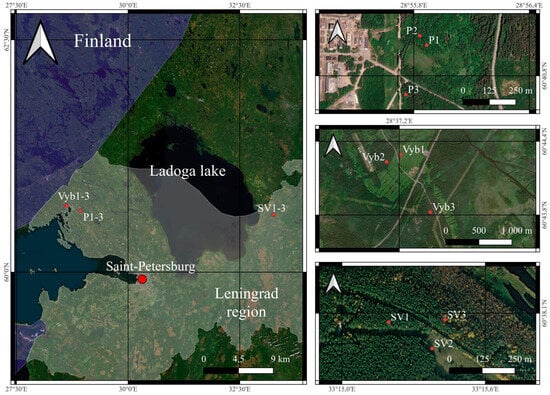
Figure 1.
The study area: Leningrad Region.
The first object represents the soils of fallow lands in the northern part of the Karelian Isthmus, namely, in the territory that was part of Finland, where the drainage of inter-esker depressions was practiced, including the draining of inter-esker lakes into rivers and further into the Gulf of Finland (soil indices P1–P3). The formation of bog drainage has a long history, starting at least from the 19th century. During the Soviet period, a substantial part of drained bogs was not used in agriculture [10], although our sites were used and converted to a fallow state 15 and 30 years ago. The study area belongs to the “Vyborg” esker–hollow landscape with a dominance of flat-topped broad ridges, lake-like hollows and seaside plains. On flat watersheds, closely underlain by crystalline rocks, there is a weak runoff or even temporary stagnation of precipitation. The soil cover is dominated by stagnic podzols [23]. The soils of drained esker–hollow depressions, which were converted to a fallow state 15 and 30 years ago, as well as the benchmark zonal soil on the upland surface, were studied (Figure 2).

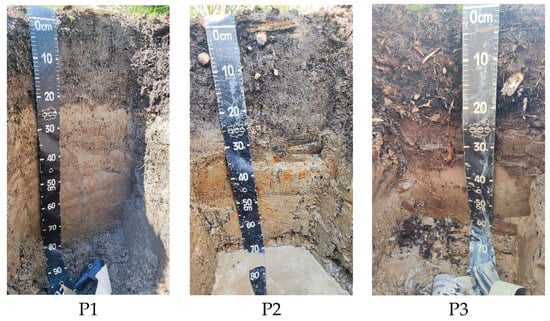
Figure 2.
Studied soils in Vyborgsky district (Perovo settlement). Р1—plaggic stagic retisol (loamic), Р2—plaggic stagic retisol (loamic), Р3—stagic retisol (loamic).
The second object is soils of fallow lands formed on the bottom of the drained lake (Vyb1–Vyb3) (Figure 3). The drainage of this area was carried out by the residents of the neighboring villages. The drained areas were occupied by rye and oat crops with clover sowing, and this area was used until the 1950s [10]. As a result of the creation of drainage reclamation systems, agricultural lands began to form on the bottom of the lake, which had existed for more than 80 years. At the present moment, the drained lake territory has undergone self-restoration for at least 70 years. Soil parent materials here are represented by lake bottom loamy sediments with the signs of a gley process.
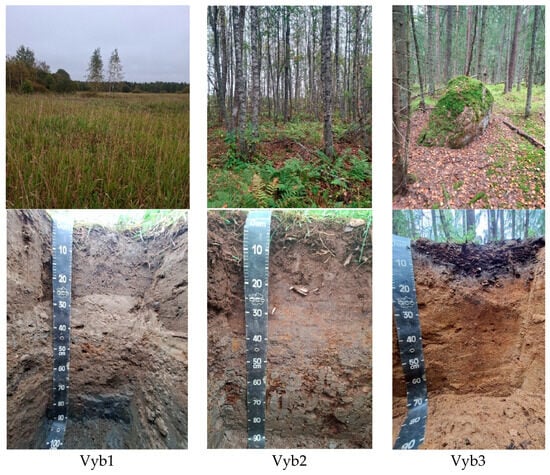
Figure 3.
Studied soils in Vyborgsky district (territory of drained lake). Vyb1—plaggic stagnic retisol (loamic), Vyb2—plaggic stagnic retisol (loamic), Vyb3—stagnic podzol (arenic).
The third object is located in the east of Leningrad Oblast (soil indices SV1–SV3). In Soviet times, the Lodeynopolsky district was drained as intensively as possible compared to other districts of the region. The territories of drained fields are located on an outcropped space composed of sandy loam materials of the Ladoga lake transgression (Figure 4). The fallow territory is occupied by different-aged forests, which is associated with the gradual abandonment of soil habitats by the local population. We studied an 86-year-old soil of fallow land under birch–aspen–pine forest and a 30-year-old soil of fallow land, post-Soviet fallow land on the field, where the processes of forestation and afforestation are currently taking place, with vegetation advancing from the edges of the field, where it is more intensively expressed, to the center of the field. The zonal benchmark soil is represented by podzol on transgressive lake sandy loam. The flat relief of the transgression plains contributed to the natural waterlogging of soils, especially at a distance from the partially draining Svir′ River.
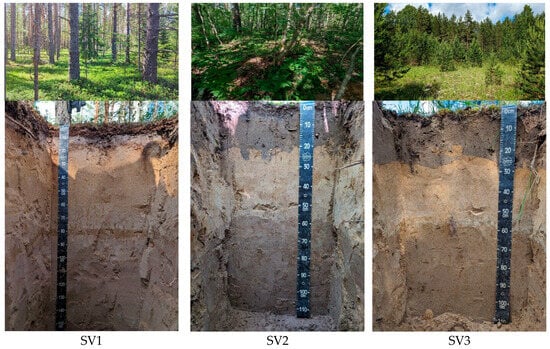
Figure 4.
Studied soils in Lodeynopolsky district. SV1—stagnic podzol (arenic), SV2—plaggic stagnic podzol (arenic), SV3—plaggic stagnic podzol (arenic).
The description of the investigated soil samples is presented in Table 1.

Table 1.
Description of the studied soils of the Leningrad Region.
2.2. Sampling Strategy
The choice of objects is conditioned by the development of soils of fallow lands on different soil parent materials, as well as different soils in the fallow state. This approach allows us to assess the rate of transformation of fallow soils within different lithological and geomorphological units and biomes of the Leningrad Region. This is due to different transition times of soils in the fallow state in close proximity to each other. Soil samples were collected from all diagnostic horizons. Five soil samples were collected from each soil horizon and further mixed to obtain a representative soil sample. Soil samples for micromorphological analysis were extracted from the soils undisturbed in order to preserve the original structure. Soils and diagnostic features were determined according to the international classifications WRB [23] and guidelines for soil description [24]. Soil samples were collected beginning in May 2024 through September 2024. Samples for chemical analyses were stored at +4 °C to analyze the main soil parameters. Soil samples were ground and passed through a 2 mm sieve to obtain the fine earth fraction. The analysis of the obtained samples was carried out from May to December 2024.
2.3. Laboratory Methods
The pH values were measured (three times) by the potentiometric method in the ratio of soil weight to volume 1:2.5 for water and 1:5 for a 1 n CaCl solution [25]. Soil carbon and total nitrogen content were determined (three times) on a CHN analyzer (EA3028-HT EuroVector, Pravia, PV, Italy), with accuracy ranges as follows: carbon—±0.01 mg or ±0.5% RSD (relative standard deviation) and nitrogen—±0.02 mg or ±0.5% RSD. The SOCstock and nitrogen stock were calculated by Formulas (1) and (2):
where (kg/m2); ρ—horizon density, g/cm3; Coc—carbon content (%); 0.1—conversion factor; H—depth, cm.
where (kg/m2); ρ—horizon density, g/cm3; N—nitrogen content (%); 0.1—conversion factor; H—depth, cm.
The particle size distribution of the samples was determined by the sedimentation (pipette) method. The content of plant-available forms of phosphorus (P2O5) was determined (three times) by the colorimetric method, and the concentrations of available potassium (K2O) were determined (three times) by flame photometer. Phosphorus and potassium were extracted from soil with 0.2 n HCl solution according to the Kirsanov method [26]. Thin sections of soil material were obtained from soil micromonoliths sampled in the field. The samples were dried and saturated with resin. The obtained thin sections were analyzed on a polarizing microscope (Leica DM750P, Leica Camera AG, Wetzlar, Germany) with LAS 4.9 software in plane polarized light and crossed polarized nicols. The terminology used in this work was published by M. I. Gerasimova [27,28] and G. Stoops [29], where soil microstructure is described in detail.
3. Results and Discussion
3.1. Features of Morphological Structure of Different-Age Soils of the Leningrad Region
The process of postagrogenic transformation is quite widespread in the Northwest of the Russian Federation. In the case of the Vyborg district (Perovo settlement), the zonal benchmark soil (P3) is formed on a thin loamy moraine overlying the eluvium of massive-crystalline rocks of a hollow esker top. Due to the relatively flat topography, moisture retention occurs here, resulting in limited development of the gley process. The fallow lands are drained by open drainage and are in an abandoned condition. The morphological structure of soils is presented in Figure 5.
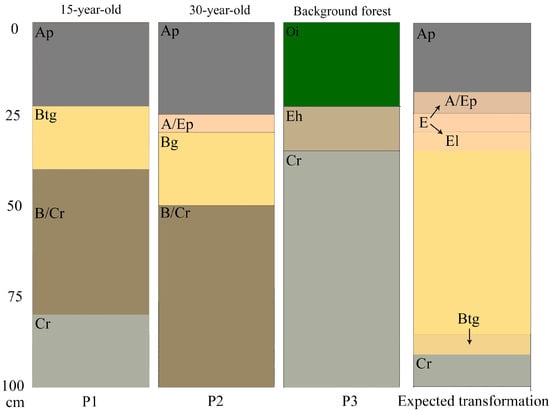
Figure 5.
The morphological characteristics of studied soil from fallow lands formed on silt–clay sediments.
The 15-year-old soil of fallow land (P1) is covered with a sparse stand of aspen, birch and willow, with some herbaceous vegetation. After 15 years, no changes related to the transformation of diagnostic soil horizons are observed. This may be due to the lithoreflectivity of soils, as well as soil cultivation [30], which leads to the preservation of soil fertility. The micromorphological structure is characterized by cloddy-type structure formation, with aggregates consisting of different-arranged microaggregate separations sticking together with humus material, which indicates the physical stability of organic material (Figure 6A,B). The formation of stable organomineral aggregates is also traced in the underlying Btg horizon, which apparently migrate here from the Ap horizon (Figure 6C,D).
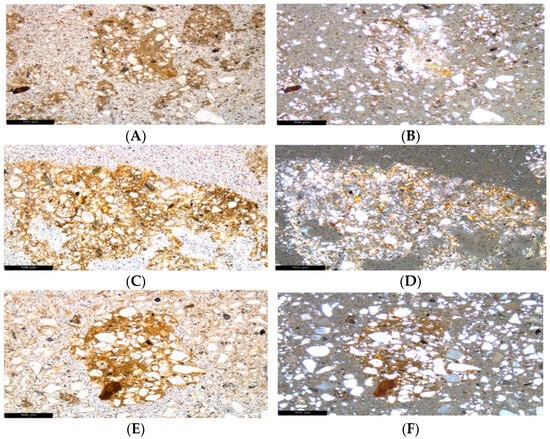
Figure 6.
Micromorphological characteristics of soils in Vyborgsky district. (A,B)—P1 Ap; (C,D)—P1 Btg; (E,F)—P2 A/Ep. (A,C,E)—parallel nicol, (B,D,F)—crossed nicol. Scale is 500 µm.
The 30-year-old soil of fallow land (P2) is occupied by birch–willow sparse forest. After 30 years, we note the formation of the A/Ep horizon, which indicates the development of the process of podzolization, resulting in the removal of silty particles and their redeposition in the underlying Bg horizon. The formation of a secondary podzolization process is a characteristic feature that indicates the degradation of the old-arable horizon. This process can be more active in soils of fallow lands than in zonal benchmark soils due to fertilizers and changes in redox conditions in the soil. The analysis of micromorphological structure showed that in 30-year-old soils of fallow lands, eluvial processes in the old-arable horizon were noted. In the upper part of the arable horizon, there are many humus films and intra-aggregate accumulations of organic matter (Figure 6E,F). The underlying soil horizons are not subjected to postagrogenic transformation. Gleyed soil parent material Cr has rounded aggregates but mostly consists of silt-sandy material characteristic of the layered sediments of inter-esker depressions. We assume that the development of the E horizon can lead to a secondary gleying process and the formation of the El subhorizon, as well as to a further transformation of the old-arable horizon and an increase in the thickness of the A/Ep horizon.
In the case of soils formed on the territory of a drained lake, the age of the deposit is estimated to be at least 80 years (Figure 7). The relief of the territory is leveled as a result of soil formation on loamy sediments, which act as a water-holding horizon, and anaerobic conditions in the soil are formed, which leads to the formation of a gley process in the underlying horizon. The fallow land is drained by open drainage, which is in an abandoned condition. A characteristic feature of fallow land soils formed on bottom sediments is the absence of the middle horizon B, so, under the old-arable horizon Ap, there are bottom sediments with signs of gleying. In the variant of 70-year-old soil of fallow land on which forest has already formed, the development of a transitional horizon is also not observed; this can be caused by the lithoreflectivity of soils, which can influence the rate of development of elementary soil processes. Lithoreflectivity is determined by the complex of edaphic, geogenic and bioclimatic properties of the territory. The zonal benchmark soil is formed on massive-crystalline esker rocks and has no similar morphological features to soils of fallow lands. It is expected that in soils of fallow lands, the process of eluviation will start, which can lead to the formation of horizon El and middle horizon Bt/Bl, where eluviation products can accumulate. At the same time, the degradation of old-arable horizon Ap will take place.
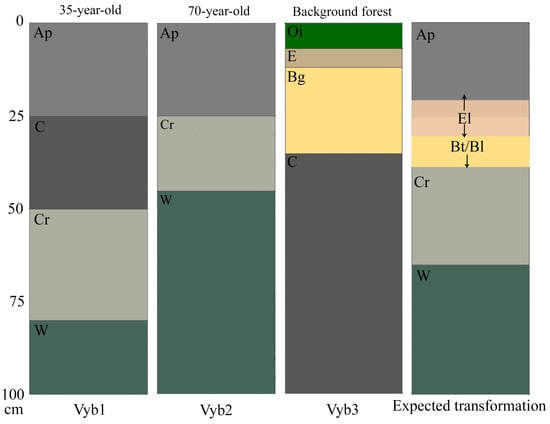
Figure 7.
The morphological characteristics of studied soils from fallow lands formed on bottom sediments.
The third site is located in Lodeynopolsky district. The benchmark soil is formed on transgressive sandy sediments of Ladoga lake (Figure 8) and has similar morphological features of structure to the benchmark soil Vyb3.
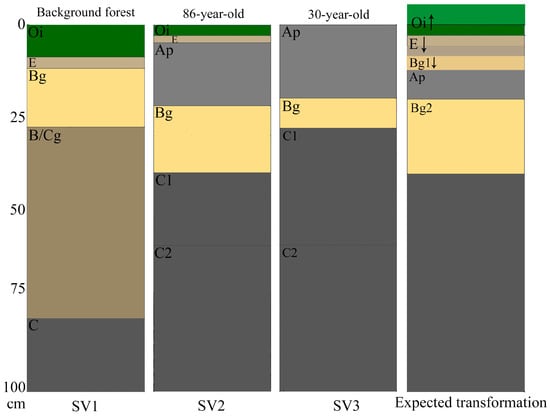
Figure 8.
The morphological characteristics of studied soils from fallow lands formed on sandy sediments.
The 30-year-old soil of fallow land is occupied by young pine trees with downland grass meadow. The formation of a secondary podzolization process is not observed here. This is confirmed at the micromorphologic level (Figure 9A,B). The old-arable horizon Ap does not show morphological changes associated with the transition to a fallow condition.
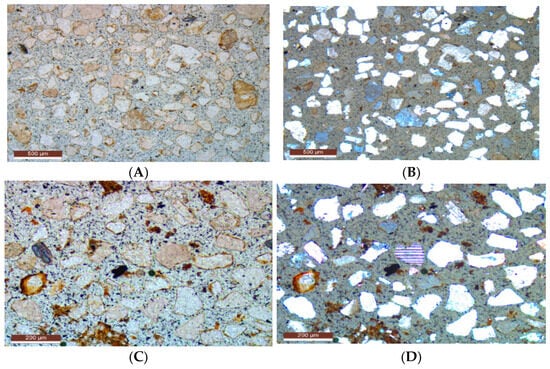
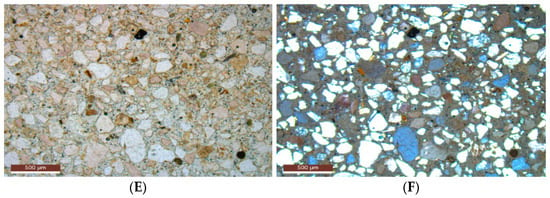
Figure 9.
Micromorphological characteristics of soils of Lodeynopolsky district. (A,B) SV2 Ap; (C,D)—SV2 E; (E,F)—SV2 Bg. (A,C,E)—parallel nicol, (B,D,F)—crossed nicol.
The older, 86-year-old fallow land soil is occupied by forest–birch–aspen–pine forest, with mountain ash and spruce in the undergrowth. Here, a secondary podzolization process led to the formation of a small separate E horizon under the litter, as well as to the development of a secondary podzolization process in the whole thickness of the old-arable Ap horizon. The secondary podzolizated part of the old-plowing horizon is more light-colored, and mineral grains here are larger in comparison with the overlying and underlying horizons (Figure 9C–F). The development of a secondary podzolization process can take place both in a short period of time and over a longer period of time, which is due to different degrees of soil cultivation [30,31]. The transformation of fallow land soils is most active in soils formed on sandy materials; this is due to the relatively weak lithoreflectivity of soils. We assume that with the increasing age of fallow land, there will be an increase in biomass and coarse forms of humus in the Oi horizon; an increase in the E horizon due to the loss of silicate clay, iron, and aluminum; and the formation of the Bgl horizon, in which there will be an accumulation of weathering products.
The large-scale degradation of agrogenic soils is caused by the discontinuation of agrotechnical techniques such as fertilizer application and calcification, as well as improvements in drainage systems. All this can lead to waterlogging and acidification, and as a consequence, soil degradation [30,32]. As a result of degradation, in addition to changes in the chemical parameters of soils, there is also a change in the morphometric parameters of soils, so for fallow land soils formed on soils with silt–clay materials, there is a change in the hydrological regime of soils. Here, there are less pronounced signs of gley, and the formation of the arable horizon also led to a shift in the boundaries of other horizons down the profile [30]. At the same time, the same processes of soil formation develop as in soils not affected by agriculture. The transition of soils to the fallow state leads to the transformation of soils towards zonal series; however, transformation processes can take place much faster than in natural soils, which is caused by earlier agrotechnical reclamation [30]. At the three studied sites, depending on the geogenic properties (material, mineralogical and chemical composition) of soils, different types of soils are formed, and the transformation of fallow lands is directed towards the benchmark analogs, except for the soils that are formed on the bottom of the drained lake. The transition of soils to the fallow state is accompanied by loss of soil fertility, which is caused by the discontinuation of mineral and organic forms of fertilization and changes in the hydrological regime of soils, as well as morphological changes [33]. The microstructure of the investigated objects has characteristic features of soil patterns formed on sandy and silt–clay materials [28], as well as postagrogenic soils characterized by increased aggregation and the presence of new formations due to the incorporation of fine organic matter into the mineral matrix of soils.
3.2. Physico-Chemical Parameters of Postagrogenic Soils of the Leningrad Region
The application of agrotechnical practices leads to a significant change in redox conditions in the soil. Soils of the Leningrad Region are characterized by acidic reactions [34], so one of the effective methods of land reclamation is calcification (CaCO3 application). As a result of the discontinuation of agriculture, soil regradation occurs and, as expected, acidity changes towards natural values [9]. The pH values we obtained are presented in Figure 10.
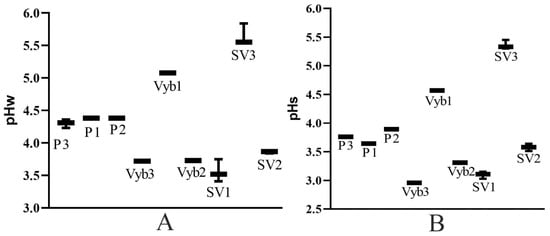
Figure 10.
Distribution of pH values in studied soils. (A)—pH in water solutions, (B)—pH in salt solutions.
Among soils formed on silt–clay materials (P1–P3) with pH values 4.3–4.38, no significant differences (r2 = 0.55; p = 0.09) among benchmark soil and soils of fallow lands of different ages were noted, which can be caused by a high level of cultivation of the territory. This thesis is confirmed by the analysis of morphological and micromorphological alterations, which show no changes in the profile structure after 15 years and weak changes after 30 years due to the high lithoreflectivity of soils formed on silt–clay materials. Soils of fallow lands formed on bottom lake sediments (Vyb1–3) are characterized by significant differences in pH values 3.72–5.08 (r2 = 0.99; p < 0.0001); this is due to the change in plant communities (meadow–small-leaved forest) and the decrease in herbaceous vegetation input into the soil [9]. As a result of the formation of forest litter on plot Vyb2, decomposition products may be formed that have an acidifying effect on the soil. The same trend is characteristic of soils formed on sandy materials (SV1–SV3); here, significant differences between various age plots were observed with pH values 3.56–5.64 (r2 = 0.98; p < 0.0001). A relatively young plot of fallow land on which forest cover has not yet had time to form is characterized by a relatively high pH level, while on the plot of 86-year-old fallow land, the pH value is close to benchmark values. This is also reflected in the morphological structure of the soil profile. In the 86-year-old fallow land, the development of a secondary podzolization process is observed, which is caused by pH change and the degradation of the mineral matrix of the soil. In soils with a low degree of cultivation and lithoreflectivity, transformation processes and soil fertility loss can occur faster than in soils formed on more cultivated areas.
3.3. Content and Stocks of Carbon and Nitrogen in Different-Age Soils of Fallow Lands
The SOC content in the studied soils shows a relatively high variability of values, from 0.99 to 22.18% (Figure 11). The highest value of SOC content was observed in the benchmark soil (Vyb3), which confirms our earlier studies on the humus state of soils in Northwest Russia [35]. We did not observe a significant correlation between SOC and the content of clay (r2 = 0.04; p = 0.62) and silt–clay (r2 = 0.002; p = 0.91).
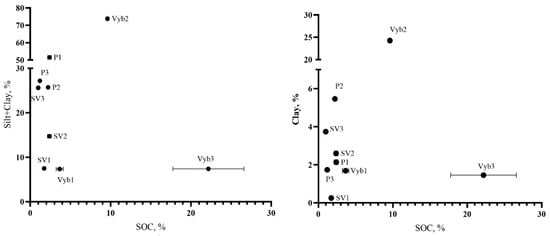
Figure 11.
Relationship between SOC content and particle size of soils.
The highest average SOC content is observed in old-arable soils formed on bottom lake sediments (Vyb1–2). At the same time, the SOC in the old plowed horizon Ap Vyb 2 reaches 9.61 ± 0.16%, and the active processes of input and humification of plant residues lead to an increase in the content of SOC [36]. According to Kurganova et al. [9], with increasing age of fallow land up to 40 years, after this age, the changes become less significant or there is a decrease in SOC in old-arable horizons. In the studied soils, we note the same trend: with increasing age, there is an increase in the content of SOC in soils, mainly due to an increase in coarse forms of humus.
In terms of carbon and nitrogen stocks at depths of 0–25 cm and 0–50 cm (Figure 12), it was found that the highest carbon stocks were found in the Vyb3 benchmark soil. Among the studied objects, the highest stocks (32.87 kg/m2) were observed in benchmark soils formed on silt–clay materials and in benchmark soils for bottom sediments. Among fallow land soils formed on sandy materials, the largest stocks (0–25 cm) were noted in 86-year-old fallow land soil (6.65 kg/m2). This is due to the formation of the Oi horizon, where weakly decomposed plant residues are accumulated, as well as the presence of old-arable horizon Ap. However, in the 0–50 cm thickness, the largest SOC stocks correspond to the benchmark soils for each object (14.9 kg/m2 for silt–clay materials, 32.87 kg/m2 for bottom sediments and 9.74 kg/m2 for sandy materials). This is due to the development of the Oi horizon and humus accumulation in the middle soil horizons. The tendency to increase the carbon content in fallow land soils in the form of coarse humus is confirmed by other researchers, such as Kalinina et al. [37]. At the early stages of soil transition to the fallow state, the main pool of carbon is located in old-arable Ap horizons. Here, the processes of humification and mineralization of organic matter take place [5]; later, with the formation of forest litter, carbon accumulates mainly in the form of coarse forms of humus and poorly transformed plant remnants [38,39]. As a result of soil transition to the fallow state, carbon accumulation occurs; so, according to estimates, from 64 to 870 Tg of carbon can be accumulated due to soil self-regeneration [40,41], mainly in the form of poorly decomposed plant residues. The mass transfer of soils into the fallow state negatively affects the stable carbon pool, as it is associated with the active processes of the transformation of organic matter applied as fertilizers to the soil; however, with the increasing time of soils in the fallow state and the formation of active carbon pool, there is a gradual increase in carbon in soils comparable to benchmark values [9]. The reintroduction of such soils will probably lead to a loss of carbon again and will require substantial economic costs, so the reintroduction of lands that have been relatively recently converted to the fallow state should be an important objective [2]. Early stages, which are not yet subject to afforestation, as well as the development of gley processes, have been less affected by postagrogenic transformation, so their soil fertility level is higher.

Figure 12.
Carbon and nitrogen stocks in studied soils.
As for nitrogen stocks in the soil, we can note that the highest stocks correspond to the 70-year-old fallow land soil, which is probably associated with the accumulation of nitrogen in the undecomposed plant residues in the Oi horizon, as well as in the old-arable Ap horizon. The same pattern is characteristic for old plough soils formed on sandy sediments; 86-year-old fallow land soil is characterized by the highest nitrogen content among the soils of this object. As a result of the demutational succession of meadow communities to small-leaved forests, there may be a peak of nitrogen input into the soil due to aboveground leaf litter and parts of root biomass [9].
3.4. Features of Accumulation and Migration of Biogenic Elements in Different-Age Soils of Fallow Lands
Soils of fallow lands are able to release biogenic elements accumulated during agricultural cultivation for a long time. The rate of release depends on morphological features of soil, hydrological regime, and time of soil transition to the fallow state. Figure 13 presents the data on the content of nutrients in the studied soils. Among all investigated objects, it was noted that the highest phosphorus content corresponds to soils of fallow lands (45.6 ± 5.7 mg/kg for silt–clay materials, 147 mg/kg for bottom sediments and 110.6 ± 28.2 mg/kg for sandy materials). In fallow land soils, phosphorus can be retained for a long time in old-arable horizons; its migration down the profile depends on the time of transition to the fallow state, the degree of soil profile moistening and the plant coverage of the soil surface [30,42]. We found a relatively high level of correlation between pH and phosphorus content (r = 0.42, p = 0.012); this is due to the development of the process of podzol formation, in which at low pH levels, phosphorus is leached from the upper horizons and stored with sesquioxides. The highest average phosphorus content is observed in soils of fallow lands formed on bottom lake sediments—147 mg/kg. A decrease in phosphorus content is noted in the underlying horizons due to migration with the downward flow of moisture [30]. The studied objects show a decrease in phosphorus content with increasing time in the fallow state, but the rate of phosphorus removal is determined by the degree of soil cultivation [9]. Potassium accumulation in soils of fallow lands occurs in the underlying horizons; this is due to the migration of potassium from the upper horizons of soils (58 → 142 mg/kg for soil on silt–clay materials, 147 → 235 mg/kg for soil on bottom sediments), which could be applied here as a meliorant. In the upper humus-accumulative horizons of the studied soils, the highest values correspond to soils of fallow lands formed on silt–clay materials and lake sediments. For soils of fallow lands formed on sandy materials, no significant differences between the potassium content in benchmark samples and fallow land soils were revealed. Old-arable horizons lose potassium rather quickly; this is caused by the active involvement of potassium in plant nutrition and loss as a result of downward migration. There is an increase in potassium content with increasing age of fallow and forest litter formation for soils on bottom sediments and sandy materials (76 → 110 mg/kg and 14 → 30 mg/kg, respectively) and a decrease in soils on silt–clay materials (58 → 49 mg/kg). According to Litvinovich et al. [30], the transition of soils into the fallow state is accompanied by potassium depletion at early stages, and then its gradual increase to the level of benchmark values.

Figure 13.
The content of biogenic elements in studied soils from humus-accumulative horizons. (A)—phosphorus, (B)—potassium, (С)—nitrogen nitrate (N-NO3), (D)—ammonium nitrogen (N-NH4).
The content of nitrate forms of nitrogen in the studied soils was relatively low (0.05–7.55 mg/kg and 0.06–16.7 mg/kg, respectively); fallow land soils lose nitrogen rather quickly if leguminous plants are absent in the plant communities. The highest nitrate nitrogen content was observed in fallow 86-year-old fallow land soil (SV2) formed on sandy material—7.55 ± 0.41 mg/kg, which may indicate nitrogen fixation from the atmosphere. The content of the ammonia form of nitrogen among the studied objects is maximum in fallow land soils; in the case of soils formed on silt–clay materials at the youngest site (P1—15 years), it was 13.3 ± 1.6 mg/kg. For soils formed on sandy materials and lake sediments, the highest content was observed in the most aged sites of fallow land. According to Nizamutdinov et al. [42], with the increasing age of the fallow state, the values of ammonium nitrogen content may increase due to the activity of microbiota, as well as the features of melioration in the past.
The postagrogenic transformation of soils has a significant impact on the accumulation and redistribution of nutrient elements in soils of fallow lands. Depending on local geogenic conditions, soils of fallow lands are able to retain a relatively high level of soil fertility due to well-cultivated areas, but with increasing time in the fallow state, the zonal processes of soil formation are more and more active in soils, and their soil fertility level decreases to natural rates.
Based on the obtained correlation matrix (Figure 14A), it was revealed that there is a strong positive correlation between clay content and potassium (r = 0.71, p < 0.001), and dust and potassium (r = 0.61, p < 0.001); thus, the highest potassium content was observed in soils of fallow lands formed on silt–clay materials. There is a high correlation between the content of SOC and nitrogen (r = 0.88, p < 0.001). This is due to the active input and transformation of plant residues in the soil.


Figure 14.
Correlation matrix (Pearson correlation) of studied soils (A). Biplot of principal component analysis (PCA) (B).
According to PCA (Figure 14B), it was found that for PC1, the highest loadings are sand (0.83), clay (−0.76), dust (−0.76) and potassium (−0.73). For PC2, the highest loadings are for SOC (0.53), nitrogen (0.47) and pHw (−0.65). The composition of parent materials on which fallow land soils develop plays an important role in soil transformation and determines the further direction of soil development.
4. Conclusions
Postagrogenic transformation is an important driver of landscape change in a large part of the Northwest of Russia. As a result of soil transition to the fallow state, significant changes occur at morphological and micromorphological levels, the development of which depends on particle-size distribution and moves towards zonal soil types. The formation of transitional horizon A/Ep, as well as an increase in the thickness of E horizon, is a sign of the degradation of arable horizons of soils and indicates loss of fertility. Soils formed on silt–clay parent materials are characterized by less fertility loss in relation to soils formed on sand parent materials, which is due to the formation of stable organomineral aggregates in the soil structure. On the side of physicochemical parameters, in old-arable soils, there is a change in pH towards benchmark values, which is caused by the increase in the amount of forest litter and the formation of the Oi horizon. In the studied soils, pH values significantly change towards zonal analogues after 30 years of being in the fallow state; this is characteristic both for soils formed on bottom sediments (benchmark—3.72 pH value and 70 years old—3.73 pH value) and for soils on sandy parent materials (benchmark—3.56 pH value and 86 years old—3.85 pH value). A pH decrease can influence the development of the podzol process and the degradation of old plough horizons. For soil on silt–clay parent materials, there was a decrease in carbon content from 2.39 ± 0.23% to 2.22 ± 0.06% after 30 years of being in the fallow state, but for soils formed on bottom sediments and sandy parent materials, an increase in carbon content in old plough horizons from 3.66 ± 0.43% to 9.61 ± 0.16% and from 0.99 ± 2.37% to 2.37 ± 0.25%, respectively, was noted. The increase in the input of forest litter is indicated in the increase of SOC stocks in old-arable soils, which is due to the accumulation of carbon both in the form of coarse humus and in the composition of old-arable soil horizons. In terms of biogenic elements, it was found that soils of fallow lands are able to retain a relatively high level of soil fertility for a long time. Phosphorus and potassium can migrate relatively quickly through the soil profile; on the contrary, nitrate and ammonium forms of nitrogen can show growth, which is caused by demutational succession and the input of a large amount of forest litter into the soil. Soils formed on silt–clay materials are characterized by a decrease in phosphorus content of 45.6 ± 5.7 → 38 ± 15.3 mg/kg, potassium 58 ± 2.6 → 49.3 ± 0.88 mg/kg, nitrate nitrogen 0.28 ± 0.21 → 0.12 mg/kg and ammonium nitrogen 13.3 ± 1.6 → 5.9 ± 2.4 mg/kg in the period from 15 to 30 years of being in the fallow state. Soils formed on bottom sediments are characterized by a decrease in phosphorus content of 147 → 85 mg/kg and an increase in potassium content 76 → 110 mg/kg, nitrate nitrogen 0.79 → 5.04 mg/kg and ammonium nitrogen 6.21 → 16.17 mg/kg in the period from 35 to 70 years of being in the fallow state. Soils formed on sandy materials showed a decrease in phosphorus content of 110.6 ± 28.2 → 90.6 ± 2.4 mg/kg and an increase in potassium content 14 ± 1.3 → 30 ± 0.66 mg/kg, nitrate nitrogen 0.05 ± 0.02 → 7.5 ± 0.4 mg/kg and ammonium nitrogen from 3.8 ± 0.15 to 7.69 ± 0.7 mg/kg in the period from 30 to 86 years of the fallow state. The transformation of fallow lands in the Northwest of Russia is a complex process, including the degradation of arable horizons, change in soil properties in the direction of zonal analogs and redistribution of nutrients and organic matter; the speed and direction of changes depend significantly on parent materials. This determines the necessity of a differentiated approach to potential reclamation or conservation use.
The limitation of this research is the lack of long-term, reliable sampling of chronosequence, both within the Northwest of Russia and within a single site; in our study, the age of the lands varied from 15 to 86 years, which does not provide complete information on zonal cycles of soil formation. Due to the complex and long history of the cultivation of the territory and the development of drainage networks, such information is practically not preserved until nowadays, which complicates the interpretation of the obtained data.
Author Contributions
Conceptualization, V.P. and E.A. (Evgeny Abakumov); methodology, V.P. and T.N.; software, V.P.; validation, T.N., E.A. (Egor Artyukhov), V.P. and E.A. (Evgeny Abakumov); formal analysis, V.P.; investigation, I.P., E.A. (Evgeny Abakumov) and V.P.; resources, T.N. and V.P.; data curation, V.P.; writing—original draft preparation, V.P.; writing—review and editing, V.P. and E.A. (Evgeny Abakumov); visualization, V.P.; supervision, E.A. (Evgeny Abakumov); project administration, E.A. (Evgeny Abakumov); funding acquisition, E.A. (Evgeny Abakumov). All authors have read and agreed to the published version of the manuscript.
Funding
This work was supported by the Russian Scientific Foundation in accordance with the agreement from 20 April 2023 No. 23-16-20003 and the Saint-Petersburg Scientific Foundation in accordance with the agreement from 5 May 2023 No. 23-16-20003.
Data Availability Statement
The data for physico-chemical parameters were obtained from the Applied Ecology laboratory of Saint-Petersburg State University.
Acknowledgments
This research was partially supported by the scientific equipment of “Center of Chemical Analyses and Materials” of Saint-Petersburg state University.
Conflicts of Interest
The authors declare no conflicts of interest.
Abbreviations
The following abbreviations are used in this manuscript:
| SOC | Soil organic carbon |
| PCA | Principal component analysis |
References
- Foley, J.A.; Monfreda, C.; Ramankutty, N.; Zaks, D. Our share of the planetary pie. Proc. Natl. Acad. Sci. USA 2007, 104, 12585–12586. [Google Scholar] [CrossRef]
- Vuichard, N.; Ciais, P.; Belelli, L.; Smith, P.; Valentini, R. Carbon sequestration due to the abandonment of agriculture in the former USSR since 1990. Glob. Biogeochem. Cycles 2008, 22, 1–8. [Google Scholar] [CrossRef]
- Ovsepyan, L.; Kurganova, I.; de Gerenyu, V.L.; Kuzyakov, Y. Recovery of organic matter and microbial biomass after abandonment of degraded agricultural soils: The influence of climate. Land Degrad. Dev. 2019, 30, 1861–1874. [Google Scholar] [CrossRef]
- Kurganova, I.; Lopes de Gerenyu, V.; Kuzyakov, Y. Large-scale carbon sequestration in post-agrogenic ecosystems in Russia and Kazakhstan. CATENA 2015, 133, 461–466. [Google Scholar] [CrossRef]
- Lyuri, D.I.; Goryachkin, S.V.; Karavaeva, N.A.; Denisenko, E.A.; Nefedova, T.G. Dynamics of Agricultural Lands of Russia in XX Century and Postagrogenic Restoration of Vegetation and Soils; GEOS: Moscow, Russia, 2010; p. 420. [Google Scholar]
- Anpilogova, D.; Pakina, A. Assessing ecosystem services of abandoned agricultural lands: A case study in the forested zone of European Russia. One Ecosyst. 2022, 7, e77969. [Google Scholar] [CrossRef]
- Kalinina, O.; Goryachkin, S.V.; Karavaeva, N.A.; Lyuri, D.I.; Najdenko, L.; Giani, L. Self-restoration of post-agrogenic sandy soils in the southern Taiga of Russia: Soil development, nutrient status, and carbon dynamics. Geoderma 2009, 152, 35–42. [Google Scholar] [CrossRef]
- Post, W.M.; Kwon, K.C. Soil carbon sequestration and land-use change: Processes and potential. Glob. Change Biol. 2000, 6, 317–327. [Google Scholar] [CrossRef]
- Kurganova, I.N.; Telesnina, V.M.; Lopes de Gerenyu, V.O.; Lichko, V.I.; Ovsepyan, L.A. Changes in the Carbon Stocks, Microbial and Enzyme Activities of Retic Albic Podzol in Southern Taiga during Postagrogenic Evolution. Eurasian Soil Sci. 2022, 55, 895–910. [Google Scholar] [CrossRef]
- Isachenko, G.A. “Window to Europe”: History and Landscapes; Saint-Petersburg State University: Saint-Petersburg, Russia, 1998; p. 476. [Google Scholar]
- Sukhacheva, E.Y. Principles and methods of a digital medium scale soil map creation of the Leningrad region. Vestnik of Saint Petersburg University. Earth Sci. 2019, 64, 100–113. [Google Scholar]
- Chebykina, E.; Shamilishvilly, G.; Kouzov, S.; Abakumov, E. Soils of external islands of the Gulf of Finland: Soil pollution status and dynamics in abandoned agricultural ecosystems. Soil Water Res. 2022, 17, 243–250. [Google Scholar] [CrossRef]
- Morris, S.J.; Bohm, S.; Haile-Mariam, S.; Paul, E.A. Evaluation of carbon accrual in afforested agricultural soils. Glob. Change Biol. 2007, 13, 1145–1156. [Google Scholar] [CrossRef]
- Poeplau, C.; Don, A. Sensitivity of soil organic carbon stocks and fractions to different land-use changes across Europe. Geoderma 2013, 192, 189–201. [Google Scholar] [CrossRef]
- Makarova, M.V.; Abakumov, E.V.; Shevchenko, E.V.; Paramonova, N.N.; Pakhomova, N.V.; Lvova, N.A.; Vetrova, M.A.; Foka, S.C.; Guzov, Y.N.; Ivakhov, V.M.; et al. From carbon polygon to carbon farm: The potential and ways of developing the sequestration carbon industry in the Leningrad Region and St Petersburg. Vestnik of Saint Petersburg University. Earth Sci. 2023, 68. [Google Scholar] [CrossRef]
- Vladychensky, A.S.; Telesnina, V.M. Comparative characteristic of south taiga post- agrogenic soil humus indexes for different litology conditions. Mosc. Univ. Soil Sci. Bull. 2007, 4, 3–10. [Google Scholar]
- Gagarina, E.I. Lithological Factor of Soil Formation (by the Example of the North-West Russian Plain); Saint-Petersburg State University: Saint-Petersburg, Russia, 2004; p. 260. [Google Scholar]
- Dayneko, D.; Rusakov, A. Influence of anthills on fallow soils: A case study of Yaroslavskaya and Leningradskaya Regions. Biol. Commun. 2012, 2, 120–130. [Google Scholar]
- Lavrishchev, A.; Litvinovich, A.; Abakumov, E.; Kimeklis, A.; Gladkov, G.; Andronov, E.; Polyakov, V. Soil Microbiome of Abandoned Plaggic Podzol of Different-Aged Fallow Lands and Native Podzol in South Taiga (Leningrad Region). Agronomy 2024, 14, 429. [Google Scholar] [CrossRef]
- Rautiainen, A.; Virtanen, T.; Kauppi, P.E. Land cover change on the Isthmus of Karelia 1939–2005: Agricultural abandonment and natural succession. Environ. Sci. Policy 2016, 55, 127–134. [Google Scholar] [CrossRef]
- Abakumov, E.; Polyakov, V.; Orlova, K. Podzol development on different aged coastal bars of Lake Ladoga. Tomsk. State Univ. J. Biol. 2019, 48, 6–31. [Google Scholar] [CrossRef]
- Beck, H.E.; Zimmermann, N.E.; McVicar, T.R.; Vergopolan, N.; Berg, A.; Wood, E.F. Present and future Köppen-Geiger climate classification maps at 1-km resolution. Sci. Data 2018, 5, 180214. [Google Scholar] [CrossRef]
- IUSS Working Group WRB. World Reference Base for Soil Resources. In International Soil Classification System for Naming Soils and Creating Legends for Soil Maps, 4th ed.; International Union of Soil Sciences: Vienna, Austria, 2022; p. 234. [Google Scholar]
- Jahn, R.; Blume, H.P.; Spaargaren, O.; Schad, P. Guidelines for Soil Description; Food and Agriculture Organization of the United Nations: Rome, Italy, 2006; p. 98. [Google Scholar]
- Carter, M.; Gregorich, E. Soil Sampling and Methods of Analysis; Carter, M., Gregorich, E., Eds.; Taylor & Francis: London, UK, 2006; p. 198. [Google Scholar]
- GOST. Determination of Mobile Phosphorus and Potassium Compounds by Kirsanov Method Modified by ClNAO; Pryanishnikov Institute of Agrochemistry: Moscow, Russia, 2011; p. 8. [Google Scholar]
- Gerasimova, M.; Kovda, I.; Lebedeva, M.; Tursina, T. Micromorphological Terms: The State of the Art in Soil Microfabric Research. Eurasian Soil Sci. 2011, 44, 739–752. [Google Scholar] [CrossRef]
- Gerasimova, M.I.; Savitskaya, N.V. Micromorphological Interpretation of Natural and Anthropogenic Evolution of Soils in Bykovo Lacustrine-Alluvial Section of the Moskva River Floodplain. Eurasian Soil Sci. 2020, 53, 950–959. [Google Scholar] [CrossRef]
- Stoops, G. Guidelines for Analysis and Description of Soil and Regolith Thin Sections; John Wiley & Sons, Inc.: Hoboken, NJ, USA, 2020. [Google Scholar]
- Litvinovich, A.; Pavlova, О.; Lavrishchev, A.; Bure, V. Study of Indicators of Soil Fertility of Cultivated Sod-Podzolic Sandy Soil at Different Stages of Formation of Natural Ecosystems. Agrochemistry 2022, 6, 14–27. [Google Scholar] [CrossRef]
- Azarenko, M.A.; Kazeev, K.S.; Yermolayeva, O.Y.; Kolesnikov, S.I. Changes in the Plant Cover and Biological Properties of Chernozems in the Postagrogenic Period. Eurasian Soil Sci. 2020, 53, 1645–1654. [Google Scholar] [CrossRef]
- Litvinovich, A.V. Postagrogenic Evolution of Well Cultivated Soddy-Podzolic Soils in the Northwestern Nonchernozemic Zone. Agronomy 2009, 7, 85–93. [Google Scholar]
- Titlyanova, A.A.; Naumov, A.V. Carbon losses from soils of Western Siberia under agriculture. Eurasian Soil Sci. 1995, 11, 1357–1362. [Google Scholar]
- Kokotov, Y.A.; Sukhacheva, E.Y.; Aparin, B.F. Acidity field of soils as ion-exchange systems and the diagnostics of genetic soil horizons. Eurasian Soil Sci. 2014, 47, 1227–1237. [Google Scholar] [CrossRef]
- Polyakov, V.; Abakumov, E. Estimation of Carbon Stocks and Carbon Sequestration Rates in Abandoned Agricultural Soils of Northwest Russia. Atmosphere 2023, 14, 1370. [Google Scholar] [CrossRef]
- Kalinina, O.; Goryachkin, S.V.; Lyuri, D.I.; Giani, L. Post-agrogenic development of vegetation, soils, and carbon stocks under self-restoration in different climatic zones of European Russia. CATENA 2015, 129, 18–29. [Google Scholar] [CrossRef]
- Kalinina, O.; Cherkinsky, A.; Chertov, O.; Goryachkin, S.; Kurganova, I.; Lopes de Gerenyu, V.; Lyuri, D.; Kuzyakov, Y.; Giani, L. Post-agricultural restoration: Implications for dynamics of soil organic matter pools. CATENA 2019, 181, 104096. [Google Scholar] [CrossRef]
- Guo, L.B.; Gifford, R.M. Soil carbon stocks and land use change: A meta analysis. Glob. Change Biol. 2002, 8, 345–360. [Google Scholar] [CrossRef]
- Petaja, G.; Bārdule, A.; Zalmanis, J.; Lazdiņa, D.; Daugaviete, M.; Skranda, I.; Zvaigzne, Z.A.; Purviņa, D. Changes in Organic Carbon Stock in Soil and Whole Tree Biomass in Afforested Areas in Latvia. Plants 2023, 12, 2264. [Google Scholar] [CrossRef] [PubMed]
- Henebry, G.M. Carbon in idle croplands. Nature 2009, 457, 1089–1090. [Google Scholar] [CrossRef] [PubMed]
- Schierhorn, F.; Müller, D.; Beringer, T.; Prishchepov, A.V.; Kuemmerle, T.; Balmann, A. Post-Soviet cropland abandonment and carbon sequestration in European Russia, Ukraine, and Belarus. Glob. Biogeochem. Cycles 2013, 27, 1175–1185. [Google Scholar] [CrossRef]
- Nizamutdinov, T.; Yang, S.; Abakumov, E. Post-Agricultural Shifts in Soils of Subarctic Environment on the Example of Plaggic Podzols Chronosequence. Agronomy 2025, 15, 584. [Google Scholar] [CrossRef]
Disclaimer/Publisher’s Note: The statements, opinions and data contained in all publications are solely those of the individual author(s) and contributor(s) and not of MDPI and/or the editor(s). MDPI and/or the editor(s) disclaim responsibility for any injury to people or property resulting from any ideas, methods, instructions or products referred to in the content. |
© 2025 by the authors. Licensee MDPI, Basel, Switzerland. This article is an open access article distributed under the terms and conditions of the Creative Commons Attribution (CC BY) license (https://creativecommons.org/licenses/by/4.0/).